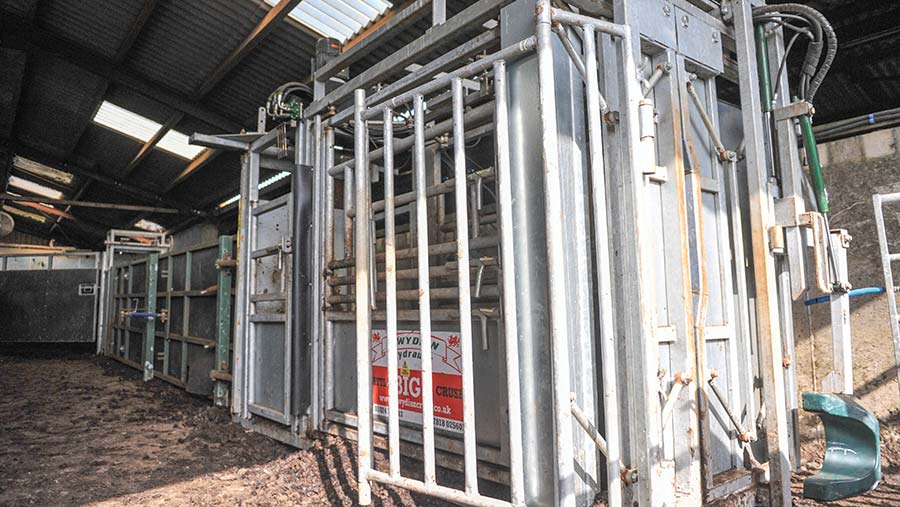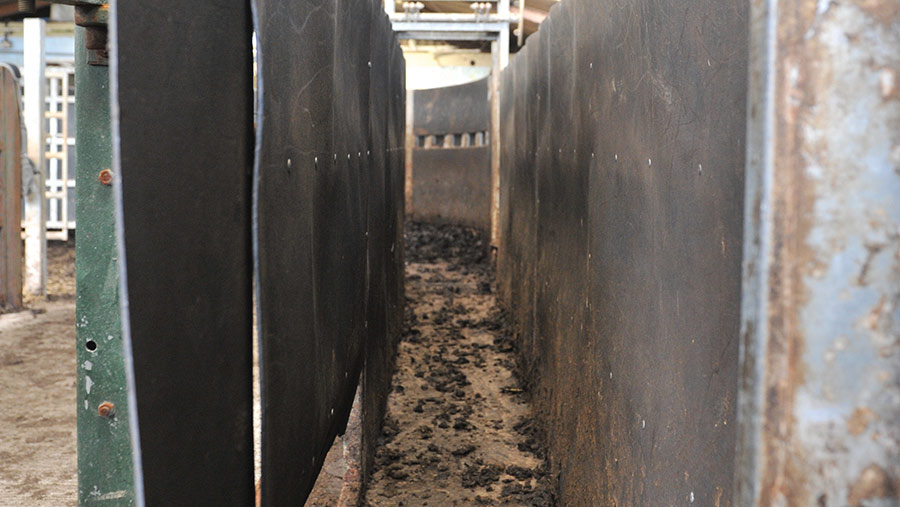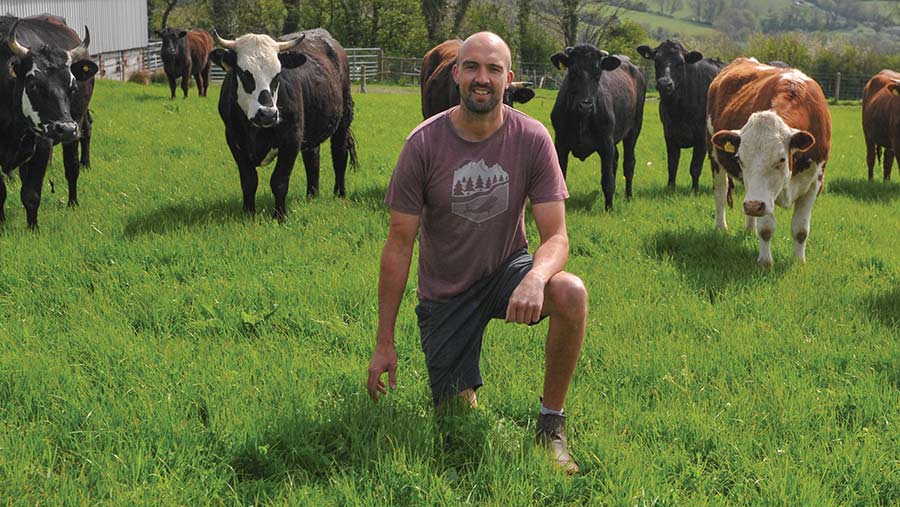Custom-made cattle handling system improves speed and safety
 © Debbie James
© Debbie James Custom-designed handling facilities enable a dairy-calf-rearing and beef-finishing enterprise to handle up to 100 cattle an hour with just one operator.
Aled and Iwan Evans run 640 cattle at different stages of production on a rotational grazing system in Carmarthenshire.
At least every four weeks they handle numerous groups of animals ranging in weight from 200kg to 650kg, drafting and tracking growth rates.
See also: 3 cattle handling kit options to stay safe at calving
The business was established on a former dairy farm in 2016 and the brothers spent the next 18 months designing and constructing a new fit-for-purpose handling system.
Their priorities were efficiency through speed of cattle movement, and handler and animal safety.
“Constructing new handling is a major and long-term investment, so we wanted to get the design right from the start,” says Aled.
Farm facts
Rest Farm, Carmarthen
- 332ha (820 acres) farmed
- Rotational grazing with daily moves
- Weekly grass measuring
- 85% grass utilisation
- Finishing 325 cattle a year, sold directly to London-based restaurant chain Honest Burgers and two ethical butchers
- 700 Romney ewes
At the planning stage, a lot of thought was given to animal size, group size and labour requirement, as big mobs of cattle are handled from six months of age.
An ability to draft freely to allow the smooth operation of routine actions, from weighing and dosing to drafting for slaughter, was a focal point too.
“Efficiency is important – we have got to handle bigger numbers of cattle with fewer labour units and with only so many hours in the day,” says Aled.
Another priority was to have the operator area free from cattle.
Curved forcing pen
A redundant milking parlour at Rest Farm, Henllan Amgoed, provided an existing roofed area to house the new facility.
The design the Evanses settled on incorporates some of the principles of animal behaviour expert Temple Grandin, and in particular, a forcing pen that is curved.
This concept has been shown to funnel cattle into a race more efficiently than a straight-sided alternative.
Cattle enter the pen from a 25x6m collecting pen on one side of the shed. To eliminate visual disturbance to keep cattle flowing, the sides of the forcing pen and race are sheeted with stock board.

© Debbie James
Adjustable race width
While the pen was an off-the-shelf purchase, the Evanses worked with a local fabricator to design and build a race with features that meet the needs of a system that handles a big range of cattle sizes.
The race needed to be wide enough for big cattle to move through freely without stress, but designed in a way that would prevent smaller animals from turning around or filing through side by side.
To achieve this, the race has been made adjustable on one side with a simple tractor top link attached to an upright steel post.
This can be used to tighten the race manually to keep the smaller cattle in single file and stop them from turning around.
While the race itself is 800mm wide – enough for the biggest animal on the farm – it can be tapered to 400mm. It serves the purpose well, but if he was installing the handling facilities now, Aled says he may have opted for a race that adjusts automatically.
“There were very few adjustable races on the market when we were designing our system, but that situation has now changed because of the grant funding available for them.
“What we have works really well, but as it is manually operated, it does reduce efficiency a little.”
The race is long enough to accommodate three full-size cattle and its sides are 1.8m above ground level.
A steel saloon door between the forcing pen and the race prevents cattle backing out of the race. A second saloon door sits between the race and the crush.
Labour-saving crush
At £10,000 in 2018, the crush was not a cheap buy, but Aled rates it as the “best buy”.
“It has saved a lot of the blood, sweat and tears from the job, and has made handling a job for one person instead of the two we needed before,” he admits.
“We clip cattle before they are sold, so this piece of kit makes it safer.”
The crush has a head scoop fitted at the front to make dosing easier. Cattle are mostly wormed just once during the grazing season as faecal egg count (FEC) testing is used to keep track of worm populations.
Blood testing in the autumn establishes if a flukicide is needed.
An intranasal pneumonia vaccination is administered within a week of cattle arriving on the farm as calves.
The crush is mounted on cordless weigh cells. These link up to a stick reader and a laptop with FarmIT 3000 software.
Data collected from EID tags include daily liveweight gain in the previous month and during the animal’s lifetime, and any treatments administered.
Use of data enables every stage of production to be carefully assessed, and informed decisions to be made about pasture allocation, finishing ration, health intervention and so on.
Cattle exit the crush into one of three drafting pens via a hydraulic shedding gate.
Top tip
As the requirements of handling vary from farm to farm, Aled says it is important to take the time and advice to get the system right.
From his own positive experience, he has a key piece of advice. “Work with a fabricator who is progressive and open-minded.”
Dairy-beef system at Rest Farm

© Debbie James
Dairy-bred beef calves are sourced from four dairy farms in spring and arrive at two weeks old.
“We have a good working relationship with our suppliers,” says Aled Evans. “We have excellent calf management protocols and we have an input into which bulls are used.”
Calves are reared in groups of 50 on skimmed milk powder until weaning at 80kg.
Most of the production comes from grazed grass, from early February to the end of November.
During December and January, cattle are housed, with growing cattle mainly in cubicles.
“We will generally incorporate on-off grazing at the shoulders of the season, which will see cattle go out for about three hours a day to transition.
This will typically buy us 30 to 40 extra days’ grazing in the year, which is a massive cost saving,” he says.
Cattle are finished in a purpose-built fattening shed at 20-24 months at an average carcass weight of 300kg.
The finishing ration consists of grass silage, red clover silage and rolled barley.
Aled reckons a bonus of handling dairy-beef compared with suckler cattle is their generally calmer nature.
The Aberdeen Angus-cross and Hereford-cross animals he buys have been bucket-reared on their source farms and are used to being around people from regular handling and daily moves between grazing breaks.
